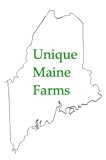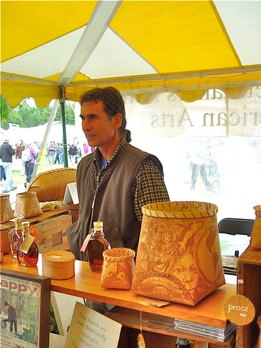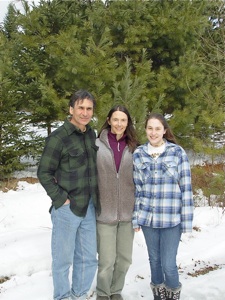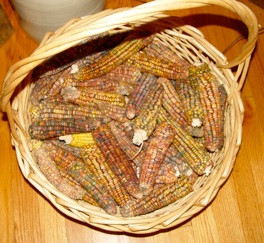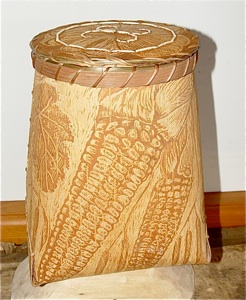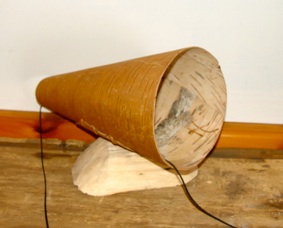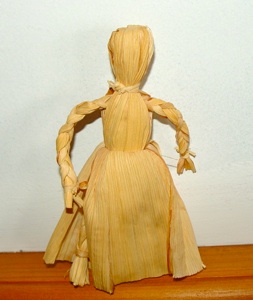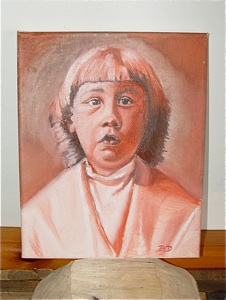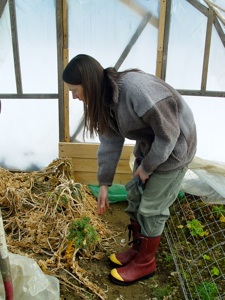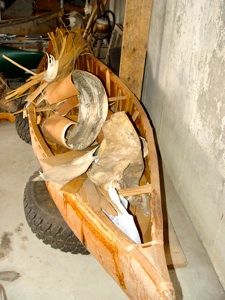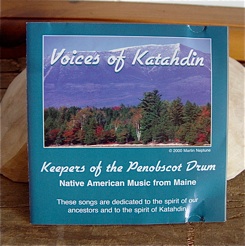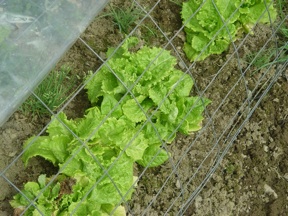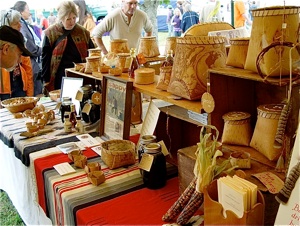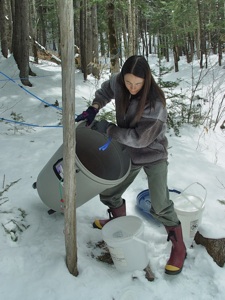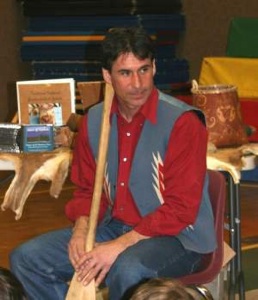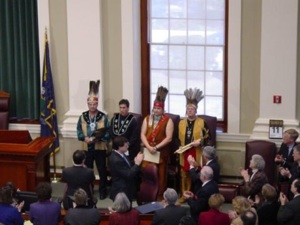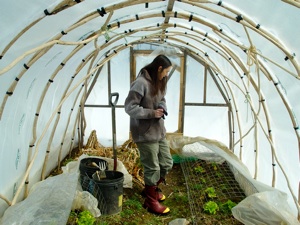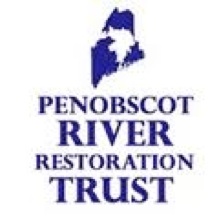Name: Barry Dana
Address: Barry Dana
46 Parkman Hill Road
Solon, Maine 04979
Phone: 207-643-2595
Products and Services:
-only Native maple syrup producer in New
England
-Wabanaki basketry
-educational programs - lectures, workshops,
demonstrations
-traditional Wabanaki art
-experiential outing program teaching Native
wilderness skills
-Penobscot drumming, songs, dance
-medicinal and edible plants
-rope making
What Makes Barry Dana’s Farm Unique?
In a project about Maine farms that attempts to be all-inclusive, it seemed essential to be able to
consider some of the agrarian activities of the
first, true indigenous peoples of the Americas. The Wabanakis (People of the Dawnland) were the Natives who inhabited the area, part of which is now known as Maine, and they include the Abenaki, Maliseet, Mik’maq, Passamaquoddy, and Penobscot Nations.
When Unique Maine Farms visited the booth of Barry Dana at the Common Ground Fair in 2012,
it was apparent that this former Penobscot Nation
Chief and well-respected Native educator, consultant, and environmentalist would be a great resource from which to learn more about the significance of farming and sustainability in the history of the Native peoples in the area that is now called Maine.
Since Native people are known to have inhabited the Northeast for thousands of years, the
“farming with nature” with which they were involved, may seem to be inconsistent with the understanding of farming as many people view it today. Because the growing season in colder climates such as Maine is so short, there was only a small window of time when the Native people could actually grow what many people would view today as “cultivated farm crops.” Corn, beans, pumpkins, Jerusalem artichokes, and squash were some of the vegetables that were planted and harvested.
The Wabanaki lived in harmony with their surroundings and theirs was what could be called “farming with nature.” The forests, rivers, oceans, islands, fields, and estuaries became their source of food. They trapped, fished, gathered, and hunted. They “farmed” with their entire natural surroundings.
Beavers, otters, bear, rabbits, deer, moose, raccoon, and wild turkeys were some of the animals that were hunted. Birds such as ducks, Canadian geese, loons, and brandts, also figured in the diets of the Wabanaki Natives. The harvesting of various plants and herbs proved to be significant parts of their diets. Hickory, chestnut, and sassafras trees were prized. The Wabanaki often traveled to areas where the natural food was located and in season, such as the berries, roots and tubers, seeds, greens, nuts, and wild fruits and vegetables. Many foods were preserved by smoking or drying them.
There was often a reliance on the marine resources of the area and Native people turned to fishing and lobsters, clams, eels, seals, whales, and even porpoise were consumed. With the snowshoes that the Wabanaki crafted, the deer and moose proved be good sources of food in the winter because the deep snow would hinder the animals as they traveled.
The Wabanaki used maple syrup for seasoning stews and covering popcorn. Barry Dana is the only Native maple syrup producer in New England. The maple syrup products that he and his wife, Lori, make from the sap that they harvest from the trees on their farm in Solon, were available for sale at the Common Ground Fair. The Danas tap around 250 to 300 trees. Lori has taken meticulous notes on the sap harvesting during the past ten years. The Danas now have an evaporator, but in the early days they had a makeshift fireplace out of cement and they tapped the trees with little plastic milk containers.
The Danas have intentionally had their maple syrup business remain a small-scale operation as they see it as a relationship and tradition that they share with the natural environment. It is their belief that incorporating the reverse osmosis procedure (that many commercial producers have embraced) affects the flavor of the syrup and eliminates valuable minerals from the water in the sap. Barry and Lori are extremely grateful to their neighbor, Richard LaCasce, who has been a great mentor in the production of maple syrup. He has generously allowed them to run one of their four sap lines on his property.
The other products which Barry had on display at his booth at the Common Ground Fair were all deeply connected with the land and the animals and plants which have always considered to be sacred beings in the homeland of Native people. Barry Dana’s art, farm, and educational outreach programs are all focused on the concept of living in balance with the earth.
The mythical Gluskabeh figures predominantly in the values and traditions of the Wabanaki culture. Katahdin was said to be his place of birth. According to Native beliefs, Gluskabeh instructed the Native peoples about the importance of cultivating a balance with all aspects of creation. Gratitude for the plants and animals was of prime importance. Gluskabeh was an advocate for the concept of taking and using only what is needed and sharing resources with one another. The Danas attempt to live and farm in accordance with Gluskabeh’s focus on the idea of harmony in nature.
In all the recorded history and in the oral traditions that have been passed down, the lifestyle of the Wabanakis was in total sync with all aspects of the natural environment. As Barry explained, “No harm was brought to any one species, the water and air remained unspoiled, the forest remained intact, and the rivers ran freely.” Survival depended on hunting, gathering, fishing, and harvesting. Various trees and plants and animals were utilized in the creation of the different tools, shelters, medicines, clothing, and foods.
Fish provided a good source of food for the Wabanakis. Some of their fishing practices included the use of spears, weirs, traps, nets, and hooks and lines. Traps and snares were used in hunting. Animal skins and the fur of mammals were used for clothing. Animal hides were transformed into wigwam and canoe coverings and bags and containers. Each part of the animal had different uses. The sinews were used for thread and bowstrings. Animal bladders would often store oil from seals. Bones would be used for needles, awls, and arrow points.
Barry and his two sisters and brother were raised on the Penobscot reservation on Indian Island by Lorraine Dana, their single mother. She was employed in a shoe factory in Old Town and she served as Tribal Clerk for the Penobscot Nation for twenty years. She was adamant that the importance of keeping the Penobscot tradition alive was imparted to her children. Barry shared that he has a great deal of gratitude to his mother and the other strong women who figured in his life while growing up on the reservation. He has wonderful memories of being sent outdoors to play. Time was spent enjoying games, competing, and exploring the Penobscot River. He learned a great deal about traditional Native skills, pride, wisdom, and values from the tribal Elders.
A love and respect for the Penobscot River is a major part of Barry’s essence. As Chief of the Penobscot Nation from 2000 to 2004, he fought
against the toxic dumping into the river and worked tirelessly to see that laws would be changed in regard to permissible discharge from the paper mills. The Penobscot River has figured predominantly in the lives of the Penobscot Nation for it served as a source of transportation as well as a home for eleven species of sea-run fish including Atlantic salmon and alewives.
Barry Dana is credited for re-initiating the spiritual journey by canoe on the Penobscot River from Indian Island to Katahdin in 1981. “The Katahdin 100” is a Native Spiritual Run, which combines a 100-mile trek by canoe, bike, and foot to Mount Katahdin. It is an event where individuals are invited to participate and it is a sacred activity that is not based on competition.
Barry was also one of the key players in the Penobscot River Restoration project which involves the collaboration of the Penobscot Indian Nation, seven conservation groups, hydropower companies, and state and federal agencies. Because of the Project, clean-up of the river has taken place and two dams have been removed on the Penobscot River and a new fish passage was constructed at the third dam with the purpose of restoring fish migration.
Barry, who is an avid runner, ran in the 2012 Boston Marathon with Team Penobscot (Barry Dana, Dale Lolar, Bob Bryant) to raise funds for the Penobscot River Restoration Project. Their running was a fitting tribute to Andrew Sockalexis from Indian Island who was runner-up at the Boston Marathon in 1912 and 1913, and to Ralph Thomas, another highly-accomplished Penobscot marathoner.
Not only does Barry Dana participate in various marathons, he also has taken part in several dog sled competitions. He has raised huskies over the years, sometimes owning as many as fourteen dogs. He explained that the Penobscot Nation has a long history associated with dogs for hunting, tracking, and companionship. Five times he has participated in the Can-Am Crown 250-mile International Sled Dog Race that departs from Fort Kent and travels through the Allagash Wilderness Waterway.
The Danas are fully committed to the traditions of the Wabanaki culture. They are attempting to grow, hunt, and gather as much of their own food as possible and tap the natural resources of the area in an environmentally conscious way. They built a hoop house out of birch saplings that has enabled them to grow greens all year long. They tilled a 2000 square foot garden by hand. They plant squash, beans, Jersualem artichokes, potatoes, cucumbers, and tomatoes. They are involved in subsistent hunting. They do not purchase any meat. Lori discussed how they successfully canned moose for the first time this past year, thanks to the guidance of one of their neighbors.
All the birchbark baskets which Barry creates are unbelievable works of art that are museum-quality. They are adorned with etchings of various animals of the forest and sky. Some are decorated with beautiful images of traditional Native crops such as pumpkins, squash, corn, and beans or pictured with Penobscot designs. Several baskets which illustrate etchings of a world map or endangered species communicate environmental messages about the critical need for the respect and preservation of the world’s animals. Leaders who have worked for peace have also been depicted on some of the baskets. Barry Dana is a truly gifted artist.
The interest in traditional Native crafts has been passed down to Barry and Lori’s daughter, who is named Sakwani after the Penobscot word for
“springtime.” Sakwani makes corn husk dolls and dream catchers from traditional materials. The Dana family brings their crafts and maple syrup each year to the Common Ground Fair in September, the Maine Native American Summer Market at the Shaker Village at Sabbathday Lake in August; and The Maine Indian Basketmakers Alliance’s sale at the College of Atlantic in July
and at the Hudson Museum in Orono in December.
Not only is Barry a gifted artist, he also is involved with preserving the music of Native people. He was the producer of “Voices of Katahdin,” a CD of traditional Penobscot music by Keepers of the Penobscot Drum. (The money earned from the sale of the CD is applied to the expenses for hosting the “Katahdin 100.”) Another CD which Barry participated in making is The Burnurwurbskek Singers CD in which inter-tribal songs have been recorded.
Barry graduated from the University of Maine at Orono with a B.S. in Education. He also has an Associates degree in Forestry. He was a teacher of the Penobscot language and culture at Indian Island Elementary School for fourteen years before heading out to teach and lead workshops throughout the state and New England.
In the educational programs that Barry Dana leads for schools (kindergarten through college), a close tie can always be discerned between the land and the natural resources of our area. Barry runs an experiential outing program teaching Native wilderness living skills. He and his family have built several wigwams. One that was constructed in 2011 is on display at the Hudson Museum in Orono. Rope making, bow and drill fire making, moose calling, and building natural shelters are some of the skills that he shares when he leads workshops.
Through the farming, artistry, crafts, music, language revitalization, traditional events, and educational outreach programs with which Barry Dana is involved, there is always an emphasis on the Native creed of the deep respect and reverence for a balance between man and nature. Barry has spent many years reaching out and sharing the traditions of the Wabanakis with so many people throughout Maine. It appears that the spirit of Gluskabeh and his teachings are being rightfully recognized. Barry’s “farming with nature” involves so many Native traditions that are worthy of being honored and cultivated.


